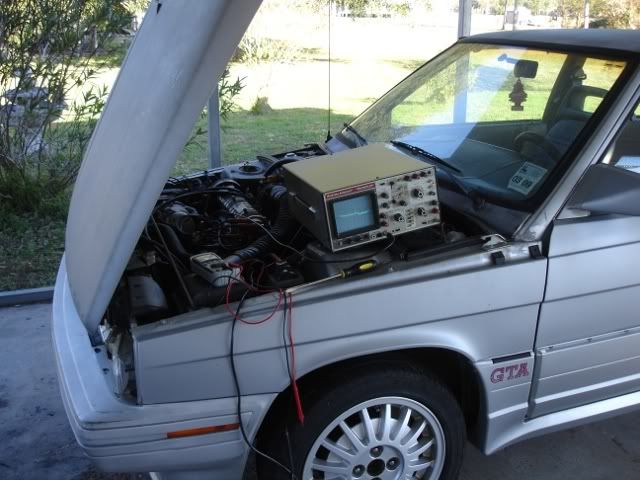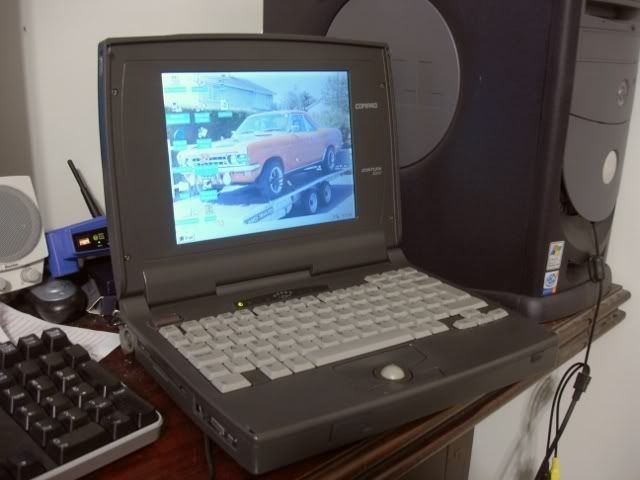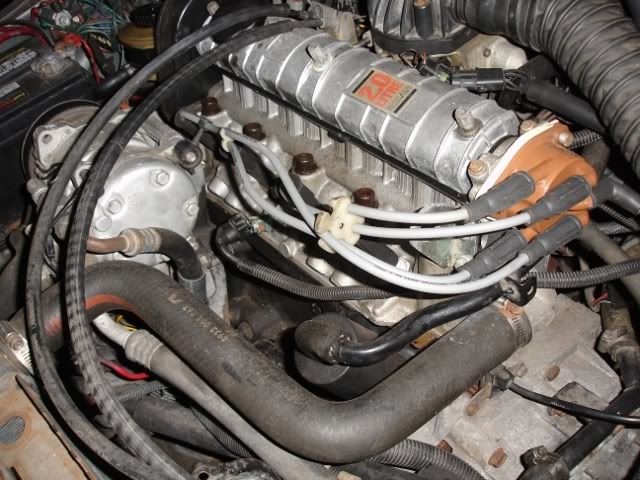|
|
|
Dec 10, 2010 13:20:45 GMT
|
Thanks for the encouragement, guys. Spent the small amount of spare time I had yesterday trying to work out the pinout of the ECU's two plugs. Of the 56 pins, I have identified 16. I am continuing on my hunt for literature! Then at least I can probe and inspect just what the ECU is being presented at its' pinblock. Might at least then get to the bottom of all this  --Phil |
| |
|
|
|
|
|
|
|
Dec 10, 2010 14:30:15 GMT
|
|
Bit of progress, digging through some very badly scanned PDF files from about 2003 I found the pinout of the ECU's plugs- the later Renix model ECU's had a single Amphenol connector with 50-odd pins all in one, and this is heralded as the single-point injection model over here, whilst the twin-plug model is the multi-point.
Well, upon removing the board a while back to repair the throttle stop motor control circuit I took a look, and indeedy, yesiree, they have used a multipoint circuitboard, torn the FETs off that would control the other 5 injectors and left a single one.
Man, this is why I love the efforts of car manufacturers during hard financial times. Not.
It's almost like working with a BL product- each serial number for each car with its' own unique configuration. No two cars are exactly alike!
It's cool and dry enough that I can now bring my oscilloscope outside with me (earlier in the year anything brought from inside with the aircon on would immediately get a liberal coating of condensation) so I can begin to probe the plugs on the back of the ECU and actually know what to expect...
--Phil
|
| |
|
|
|
|
|
Dec 10, 2010 16:41:44 GMT
|
|
|
| |
|
|
|
|
|
Dec 10, 2010 17:08:35 GMT
|
All Double Dutch to me, but at least it sounds like you know what you are talking about    It's a steep learning curve, is this electronic fuel injection. As one of the aircraft engine-men I used to work with said: "I can't be having with all these modern boxes of electrickery, it's all voodoo and squiggly-Amps!", referring to the digital traces you had to do to troubleshoot anything more complex than a carburettor. Despite growing up in an era of squiggly-Amps, there's a lot to learn. This ECU, despite being fairly old in design by modern standards is quite comprehensive in what it can do. If it logged data and was adjustable, it would do as much as a newer Megasquirt. It's all good in theory, but the electronics have aged, the wiring is French and maintenance here on the electrics is minimal to non-existant at best. They were (and still are) a very misunderstood vehicle. The failure of one sensor is enough to cause the vehicle to stop running (Crank position, MAP sensor imparticularly) or alter the fuelling so much it'd run like a bag of nails. Ironically, there is no warning light on the dash to indicate to the user (Unlike OBD-II models with the check-engine or MIL light) that a failure has occurred. On the whole people tend to ignore it, but at least it'd be addressed after a year as check-engine light on is a) a safety inspection fail and b) if you get pulled over and the cop notices the light on the dash, a ticketable offence. I'm beginning to understand the ECU's program, how it takes squiggles in on some wires and makes fuel and spark happen on the other end but when it throws its' toys out of the pram, without much in the way of diagnostic tools it can be mighty frustrating. It DOES have serial data out to let you know what it's doing, but I haven't got as far as getting anything to be able to capture that information and make sense of it... Vive la France and all that haha --Phil PS At least I can laugh at it. The ECU nearly got pulled out and thrown on the floor the other evening. |
| |
|
|
|
|
|
|
|
|
Fuel injector is... injecting. Lambda sensor seems to be dicky so that's probably half of it though unplugging it doesn't make a whole lot of difference.
Fuel injector is chucking fuel down the neck of the engine.
If I open the throttle, it continues to spray, and the engine dies.
I keep flipflopping from fuel to ignition to fuel to ignition.
I'd love to add to my arsenal:
Colortune
Vacuum gauge
Renix diagnostic unit
...
--Phil
|
| |
|
|
|
|
|
Dec 12, 2010 20:50:07 GMT
|
After a conversation with my father he suggested from the symptoms that it's both fuel and ignition. I went plugged the ECU back in and started the car up. It did its usual. I went got my neon tube spark tester to see if the spark was even getting down the wire at all. Blink blink blink. Got a flashing light. I at that point have my hand resting against the spark lead, and rev the engine. POWPOWPOWPOW from my right hand to my left (not good, I know!) The spark leads seem to be breaking down under load. Swapped the kinglead out with no4 lead. Some of the problems went away and the engine developed a slight misfire under load. Still present, and still stinking rich. Unplugged the lambda sensor... Took kit for a short spin down the road. Hesitates a little still but I got into second and up to maybe 15mph. Lots better. Get paid Friday, gunna get a new set of leads for it. Lambda sensor will probably have to wait.  Stuck my scope onto it to see if the knock sensor is putting out. It is. Despite being all smashed up. Changed out the plugs, same trick, though the current plugs are fairly pale on the electrodes. Odd. --Phil |
| |
Last Edit: Dec 12, 2010 22:58:10 GMT by PhilA
|
|
|
|
|
|
|
|
Got my old laptop to try hook up and capture the datastream the ECU puts out. Also ordered a new set of spark wires, should be here Tuesday.
No pictures. It's dark.
|
| |
|
|
|
|
|
|
|
I lied, pictures FTW.  ;D Somewhat retro laptop that I'm going to try to hook up and get my GTA to talk to. No playing videogames on this beast lol (I'm surprised I managed to hack it to run Windows 95 to be honest with you, probably my best achievement of my university days) --Phil |
| |
|
|
|
|
|
Dec 18, 2010 23:36:54 GMT
|
|
Hooking things up today revealed one of those stupid data rates- 62500 baud so the UART on the laptop read a few bits of garbage and that was about it.
Back to the drawing board, I should be able to hack a standalone serial card by changing the timing crystal on it to bring the 56k up to 62k.
Hope that'd work, but it does mean no laptop in the car, only a desktop machine set up to read what it's doing at a standstill.
Either that or I find someone who's better at electronics to create a capture device that can read that data rate and pass it to the computer.
If it's not one thing it's another.
--Phil
|
| |
|
|
|
|
|
Dec 19, 2010 22:48:34 GMT
|
Hooking things up today revealed one of those stupid data rates- 62500 baud so the UART on the laptop read a few bits of garbage and that was about it. Only the French  |
| |
|
|
|
|
|
|
|
Hooking things up today revealed one of those stupid data rates- 62500 baud so the UART on the laptop read a few bits of garbage and that was about it. Only the French  Only because in computers that divides exactly by 2,000,000 (2MHz). The standard clock speed on a serial port is roughly 1,842,000 (1.8MHz) which due to some binary mathematics is where the standard serial-port speeds you find on a PC come from. Dividing the clock speed by a smaller number alters the speed of the port. ie 1842000 divided by 32 is 57600. If the numerator is changed (clock speed) we get a different story. 2000000 divided by 32 is the 62500 I'm after. With the 2MHz crystal in the 57600 setting will give a perfect 62500  Mind you, this bus rate was probably chosen because 1,842,000 isn't a pretty number and 2,000,000 offers simplicity and elegance. Or something. Maybe Nicole/Papa liked it.  Either way, one of Amazon's finest plug-in serial cards is on order and awaiting the multiplier crystal hack. Looking at it, it's probably going to be some time after Christmas it arrives anyhow, so the car's wrapped up, drained of coolant, locked and chocked. Until then, it's collecting dust. Reminds me, I need to take the battery off... --Phil |
| |
|
|
|
|
|
|
|
|
Shame about the stall in progress, look forward to an update after Christmas
|
| |
|
|
|
|
|
Dec 20, 2010 13:52:33 GMT
|
Only because in computers that divides exactly by 2,000,000 (2MHz). The standard clock speed on a serial port is roughly 1,842,000 (1.8MHz) which due to some binary mathematics is where the standard serial-port speeds you find on a PC come from. Dividing the clock speed by a smaller number alters the speed of the port. ie 1842000 divided by 32 is 57600. If the numerator is changed (clock speed) we get a different story. 2000000 divided by 32 is the 62500 I'm after. With the 2MHz crystal in the 57600 setting will give a perfect 62500  Mind you, this bus rate was probably chosen because 1,842,000 isn't a pretty number and 2,000,000 offers simplicity and elegance. Or something. Maybe Nicole/Papa liked it.  --Phil I understand why the crystal needs changing. What baffles me is the need to make it a proprietary bus speed in the first place. What's wrong with the de-facto IT industry std of 57600??? or 9600??? |
| |
|
|
|
|
|
Dec 20, 2010 14:37:20 GMT
|
I understand why the crystal needs changing. What baffles me is the need to make it a proprietary bus speed in the first place. What's wrong with the de-facto IT industry std of 57600??? or 9600??? I think you pretty much hit it bang on the head with your first comment  I think the truth is more boring: It's a standard that never really made it. 31250 is the data rate for MIDI bus traffic amongst other things, and 62500 is just twice that. The standard serial port speeds I think came about the same as most other speed standards, in as far as "What's the fastest speed we can push down this line and not get errors?" Probably find that 0.2MHz difference is the safety buffer-zone to prevent errors from occurring. After all, you can stick that signal down 50 feet of untwisted, unshielded (edit: my bad, RS232 states the wire is shielded) wire and expect it to work. But yeah It's French, and I kinda expected something to go amiss. Shame about the stall in progress, look forward to an update after Christmas I might manage to squeeze a pittance of an update in before then. Looks like we are going to be flying out to the UK on the 23rd so there'll be a 2-week hiatus either way. --Phil |
| |
Last Edit: Dec 20, 2010 15:43:21 GMT by PhilA
|
|
|
|
|
Dec 20, 2010 20:20:10 GMT
|
|
You might be flying out, but not sure if you will be landing, most of the major airports are having serious problems with the snow again
|
| |
|
|
|
|
|
Dec 20, 2010 21:06:09 GMT
|
|
I read that. We're supposed to be flying in to Heathrow on Friday morning.
--Phil
|
| |
|
|
|
|
|
|
|
Okay. New spark leads. The idle's better now which is nice.  Still runs like a bag of nails though, it's for sure fuel. Pulled the plugs and they are white on the tips. Despite it smelling rich, it's running lean. The fuel curve must be off. Which leaves a few things. The sensors (which check out properly and read good) or the ECU has an electronic fault which is preventing it from reading the sensors correctly. That's the new theory for today as unplugging both the air temperature and coolant temperature sensors to make the ECU think it's very cold out and richen up the mixture makes it run a bit better and pop, bang and flash from the exhaust. That's probably it for now. Going to let it cool down then drain the coolant, unhook the battery and park it up for the duration. --Phil |
| |
Last Edit: Dec 22, 2010 0:13:56 GMT by PhilA
|
|
|
|
|
Dec 25, 2010 16:24:42 GMT
|
|
Parked up for now, on vacation to see the folks.
the wife stipulated I am not to be bringing lots of parts for it home- last time that was the cause of our baggage being opened for inspection as it was full of balljoints and trackrods etc...
Merry christmas, y'all.
--Phil
|
| |
|
|
|
|
|
|
|
I've just spent an hour reading this thread from top top bottom. Absolutely great work being done here!!!! I take my hat off to you for chipping away at it, you'll get there with it eventually and when you do you will be able to consider yourself INVINCIBLE. Excellent problem solving skills and quality work being done on every page.  |
| |
1974 Lancia Beta Saloon
1975 Mazda 929 Coupé
1986 Mazda 929 Wagon
1979 Mazda 929 Hardtop
1982 Fiat Argenta 2.0 iniezione elettronica
1977 Toyota Carina TA14
1989 Subaru 1800 Wagon
1982 Hyundai Pony 1200TL 2-dr
1985 Hyundai Pony 1200 GL
1986 Maserati 425 Biturbo
1992 Rover 214 SEi 5-dr
2000 Rover 45 V6 Club
1994 Peugeot 205 'Junior' Diesel
1988 Volvo 760 Turbodiesel Saloon
1992 Talbot Express Autosleeper Rambler
2003 Renault Laguna SPEARS OR REAPERS
|
|
|
|
|
|
|
I've just spent an hour reading this thread from top top bottom. Absolutely great work being done here!!!! I take my hat off to you for chipping away at it, you'll get there with it eventually and when you do you will be able to consider yourself INVINCIBLE. Excellent problem solving skills and quality work being done on every page.  To be honest, I've had a lot of help from everybody  But that's what makes this place great. Probably a few more adjustments required to the circuitry to get any data off the car, but i have a feeling it might just be the MAP and the lambda throwing the fuel out of whack now. -Phil |
| |
|
|
















